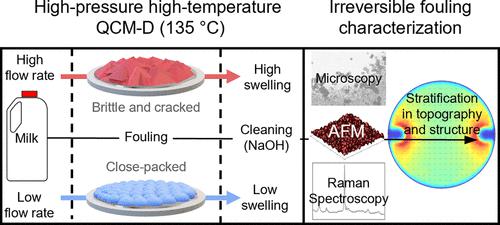Our official English website, www.x-mol.net, welcomes your
feedback! (Note: you will need to create a separate account there.)
Monitoring and Characterization of Milk Fouling on Stainless Steel Using a High-Pressure High-Temperature Quartz Crystal Microbalance with Dissipation
Langmuir ( IF 3.7 ) Pub Date : 2022-07-28 , DOI: 10.1021/acs.langmuir.2c00419 Holly A Huellemeier 1 , Necla M Eren 1, 2 , Taylor D Payne 3 , Zachary D Schultz 3 , Dennis R Heldman 1, 4
Langmuir ( IF 3.7 ) Pub Date : 2022-07-28 , DOI: 10.1021/acs.langmuir.2c00419 Holly A Huellemeier 1 , Necla M Eren 1, 2 , Taylor D Payne 3 , Zachary D Schultz 3 , Dennis R Heldman 1, 4
Affiliation

|
Fouling at interfaces deteriorates the efficiency and hygiene of processes within numerous industrial sectors, including the oil and gas, biomedical device, and food industries. In the food industry, the fouling of a complex food matrix to a heated stainless steel surface reduces production efficiency by increasing heating resistance, pumping requirements, and the frequency of cleaning operations. In this work, quartz crystal microbalance with dissipation (QCM-D) was used to study the interface formed by the fouling of milk on a stainless steel surface at different flow rates and protein concentrations at high temperatures (135 °C). Subsequently, the QCM-D response was recorded during the cleaning of the foulant. Two phases of fouling were identified. During phase-1, the fouling rate was dependent on the flow rate, while the fouling rate during phase-2 was dependent on the flow rate and protein concentration. During cleaning, foulants deposited at the higher flow rate swelled more than those deposited at the lower flow rate. The composition of the fouling deposits consisted of both protein and mineral species. Two crystalline phases of calcium phosphate, β-tricalcium phosphate and hydroxyapatite, were identified at both flow rates. Stratification in topography was observed across the surface of the QCM-D sensor with a brittle and cracked structure for deposits formed at 0.2 mL/min and a smooth and close-packed structure for deposits formed at 0.1 mL/min. These stratifications in the composition and topography were correlated to differences in the reaction time and flow dynamics at different flow rates. This high-temperature application of QCM-D to complex food systems illuminates the initial interaction between proteins and minerals and a stainless steel surface, which might otherwise be undetectable in low-temperature applications of QCM-D or at larger bench and industrial scales. The methods and results presented here have implications for optimizing processing scenarios that limit fouling formation while also enhancing removal during cleaning.
中文翻译:

使用带耗散的高压高温石英晶体微量天平监测和表征不锈钢上的牛奶污垢
界面结垢会降低许多工业部门(包括石油和天然气、生物医学设备和食品工业)的流程效率和卫生。在食品工业中,复杂的食品基质在加热的不锈钢表面上结垢会增加耐热性、泵送要求和清洁操作的频率,从而降低生产效率。在这项工作中,具有耗散的石英晶体微量天平 (QCM-D) 用于研究在高温 (135 °C) 下不同流速和蛋白质浓度下牛奶在不锈钢表面上形成的界面。随后,在清洁污垢的过程中记录了 QCM-D 响应。确定了两个结垢阶段。在第一阶段,结垢率取决于流速,而第 2 阶段的结垢率取决于流速和蛋白质浓度。在清洁过程中,以较高流速沉积的污垢比以较低流速沉积的污垢膨胀得更多。污垢沉积物的组成由蛋白质和矿物质组成。在两种流速下都鉴定出磷酸钙的两个结晶相,β-磷酸三钙和羟基磷灰石。在 QCM-D 传感器的表面上观察到形貌分层,其中以 0.2 mL/min 形成的沉积物具有易碎和破裂的结构,而以 0.1 mL/min 形成的沉积物具有光滑且紧密堆积的结构。这些成分和地形的分层与不同流速下反应时间和流动动力学的差异相关。QCM-D 在复杂食品系统中的这种高温应用揭示了蛋白质和矿物质与不锈钢表面之间的初始相互作用,否则在 QCM-D 的低温应用或更大的工作台和工业规模中可能无法检测到。此处介绍的方法和结果对于优化限制结垢形成同时还增强清洁过程中的去除的处理方案具有重要意义。
更新日期:2022-07-28
中文翻译:

使用带耗散的高压高温石英晶体微量天平监测和表征不锈钢上的牛奶污垢
界面结垢会降低许多工业部门(包括石油和天然气、生物医学设备和食品工业)的流程效率和卫生。在食品工业中,复杂的食品基质在加热的不锈钢表面上结垢会增加耐热性、泵送要求和清洁操作的频率,从而降低生产效率。在这项工作中,具有耗散的石英晶体微量天平 (QCM-D) 用于研究在高温 (135 °C) 下不同流速和蛋白质浓度下牛奶在不锈钢表面上形成的界面。随后,在清洁污垢的过程中记录了 QCM-D 响应。确定了两个结垢阶段。在第一阶段,结垢率取决于流速,而第 2 阶段的结垢率取决于流速和蛋白质浓度。在清洁过程中,以较高流速沉积的污垢比以较低流速沉积的污垢膨胀得更多。污垢沉积物的组成由蛋白质和矿物质组成。在两种流速下都鉴定出磷酸钙的两个结晶相,β-磷酸三钙和羟基磷灰石。在 QCM-D 传感器的表面上观察到形貌分层,其中以 0.2 mL/min 形成的沉积物具有易碎和破裂的结构,而以 0.1 mL/min 形成的沉积物具有光滑且紧密堆积的结构。这些成分和地形的分层与不同流速下反应时间和流动动力学的差异相关。QCM-D 在复杂食品系统中的这种高温应用揭示了蛋白质和矿物质与不锈钢表面之间的初始相互作用,否则在 QCM-D 的低温应用或更大的工作台和工业规模中可能无法检测到。此处介绍的方法和结果对于优化限制结垢形成同时还增强清洁过程中的去除的处理方案具有重要意义。











































 京公网安备 11010802027423号
京公网安备 11010802027423号